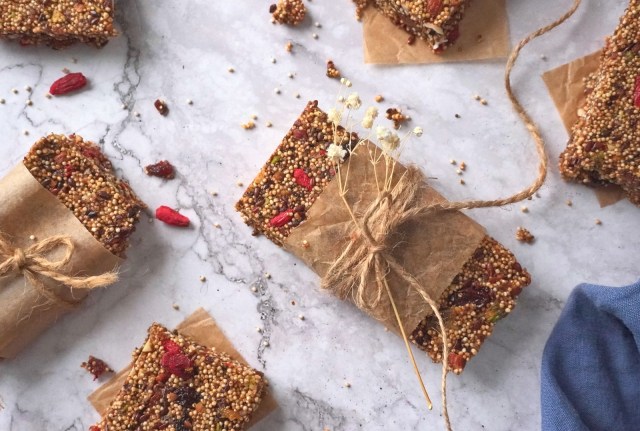Protein, fiber, and energy-packed bars that you can customize as per your taste buds. These are so easy and quick to make that there is no need to buy protein bars from the store. Moreover, homemade ones always ensure the best quality and better taste. There are NO CHEMICALS or ARTIFICIAL FLAVOURS added. And all the ingredients are clean, natural, and innocent too 🙂
Check out other Navratri Fasting Recipes too: Quinoa Pulao, Dry Fruit Milk, Buckwheat Cheela.
What is the Navratri Festival?
Navratri (also known as Navaratri or Navrate), is a joyous Hindu festival. It is celebrated over 9 to 10 days. “Navratri” is a word from the Sanskrit language – Nav means nine and Ratri means night. This festival is celebrated two times a year, once in the spring (Chaitra Navratri) and once in the autumn (Sharad Navratri). Sharad Navratri falls during September or October and is widely celebrated all across India.
One of the main aspects of Navratri is fasting (known as Vrat or Upvas). During fasting, devotees avoid eating some foods, like grains, pulses, onions, garlic, alcohol, and non-vegetarian items. But they eat fasting food items like fruits, nuts, dairy products, etc.

What food items are allowed in Navratri?
Food items that are allowed during the Navratri season are as follows:
- Vegetables like potato, tomato, arbi, cucumber, carrot, bottle gourd, eggplant, pumpkin, etc.
- Fruits
- Dairy Products
- Coconut
- Nuts and Seeds
- Quinoa, Buckwheat, Little Millet (Samai or Samak), Water Chestnut Flour (Singhade Ka Aata).
- Spices like cumin seeds, red chili powder, turmeric powder, cardamom, carom seeds (ajwain), cinnamon, cloves, black pepper, etc.
- Rock Salt
What food items are not allowed in Navratri?
Food items that are not allowed during the Navratri season are as follows:
- Onion and Garlic: They are Tamsik in nature and hence not consumed.
- Lentils and Pulses like moong dal, chana dal, kidney beans, chickpeas, etc.
- Grains and their flours like wheat flour, gram flour (besan), etc.
- Eggs, Non-Vegetarian Food Items like chicken.
- Alcohol (some people avoid smoking too).
- Salt
- Canned Food Items
Everybody has their own beliefs and follows their own rules during the fasting period. That is why, I suggest you adjust the recipes based on how you follow your fasting and celebrate Navratri.
What are Protein-Bars or Energy Bars?
Protein Bars are nutrient-dense food items packed with dried fruits, nuts, seeds, nut butter, grains, sweeteners, etc. You can customize the recipe as per your taste. It makes an easier choice to include all vital nutrients (carbs, proteins, vitamins, minerals, fat) in your diet. You can have it for an easy breakfast or for a healthy snack. You can eat it before a workout or can even pack it for your trips. Even a small bar can keep you full for a long time.
Homemade vs. Store-Bought Protein Bars
With homemade energy bars, the control of the ingredients is in your hands. You can buy the best quality ingredients and be rest assured of the food that you are consuming. A homemade one is without a doubt much healthier. Store-bought bars may contain sugar, artificial flavors, chemicals, etc. that I prefer to avoid especially when I want to eat something healthy.
These protein bars are quite easy and quick to make and can last for 2 to 3 weeks in the refrigerator. But if you do not have time and want to buy ready-made ones, always check the ingredients and buy a good quality bar.

Can I make it in the oven/microwave?
I will not suggest making it in the oven. You can roast amaranth and dry fruits (except raisins and dates) in the oven for 15 minutes. Roasting in the oven gives the best results in terms of texture and taste. It roasts the ingredients from the inside too and helps in releasing more flavors.
But this recipe is especially for those who do not have an oven/microwave.
You can roast the ingredients on the stovetop and after combining everything, let it set in the refrigerator for 4 hours.
When is the best time to eat protein bars?
Protein bars make an excellent breakfast-on-the-go option. If you don’t have time to cook anything or even sit for a few minutes for breakfast, just grab a piece of this energy bar and it will keep you full and satiated for hours. You can even eat it before or after a workout. Just see how much you want to eat. Sometimes, just half a piece is enough to keep you going. These protein bars also make a quick and easy snack option. Instead of grabbing a pack of chips, just grab a piece of energy bar. Also, make sure to eat it in moderation.
Is this recipe Vegan?
Yes. All the ingredients used in this recipe are plant-based and vegan.
How to store homemade protein bars?
Homemade protein bars can be stored in an air-tight container at room temperature for up to 1 week. You can even refrigerate for 2 to 3 weeks.
Ingredients List – for quick reference

More Navratri Fasting Recipes
- Kuttu (Buckwheat Flour) Cheela
- Quinoa Pulao
- Amaranth and Dates Energy Bars
- Quinoa Cutlets
- Sabudana Thalipeeth
Now grab all the ingredients because you are ready to make this nutrient-dense and wholesome treat at home. It is perfect for that sudden hunger pang. This way you can make a quick breakfast or dessert for yourself and your family. I am sure your kids will love it.
If you try this recipe, please share your reviews in the comment section below. Do share a photo on Instagram and tag us @thefearlesscooking. We love seeing your recreation of our recipes.

Happy Cooking. 🙂
Love from us.
Richa













Tell us what you think